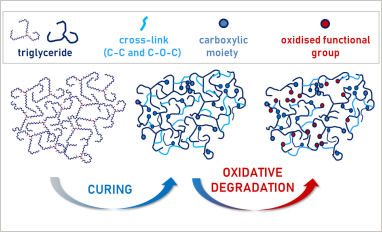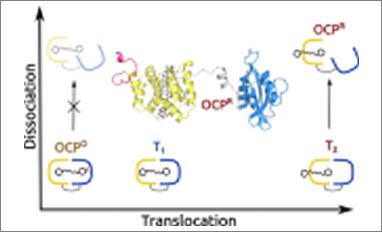
 Congratulations to our Ph.D. student Silvia Pizzimenti for her publication "Oxidation and Cross-Linking in the Curing of Air-Drying Artists’ Oil Paints" on ACS Applied Polymer Materials. The objective of this study is to improve the molecular understating of the processes that lead to the conversion of the fluid binder into a dry film, and how this evolves with time, which is at the base of a better comprehension of degradation phenomena of oil paintings, and relevant to the artists' paint manufacturing industry.
Congratulations to our Ph.D. student Silvia Pizzimenti for her publication "Oxidation and Cross-Linking in the Curing of Air-Drying Artists’ Oil Paints" on ACS Applied Polymer Materials. The objective of this study is to improve the molecular understating of the processes that lead to the conversion of the fluid binder into a dry film, and how this evolves with time, which is at the base of a better comprehension of degradation phenomena of oil paintings, and relevant to the artists' paint manufacturing industry.
 Our contribution "Extraction of proteins and residual oil from flax (Linum usitatissimum), camelina (Camelina sativa), and sunflower (Helianthus annuus) oilseed press cakes" is now published on Biomass Conversion and Biorefinery - Springer. This work targets the chemical characterization of flax cake (FC), camelina cake (CC), and sunflower cake (SC) in order to evaluate the composition of proteins and residual oil, which are two of the main components, and to assess further technological applications of these biowastes.
Our contribution "Extraction of proteins and residual oil from flax (Linum usitatissimum), camelina (Camelina sativa), and sunflower (Helianthus annuus) oilseed press cakes" is now published on Biomass Conversion and Biorefinery - Springer. This work targets the chemical characterization of flax cake (FC), camelina cake (CC), and sunflower cake (SC) in order to evaluate the composition of proteins and residual oil, which are two of the main components, and to assess further technological applications of these biowastes.
 Giant reed (Arundo donax L.) is a promising source of carbohydrates that can be converted into single cell oil (SCO) by oleaginous yeasts. Microbial conversion of both hemicellulose and cellulose fractions represents the key step for increasing the economic sustainability for SCO production. Lipomyces starkeyi DSM 70296 was cultivated in two xylose-rich hydrolysates, obtained by the microwave-assisted hydrolysis of hemicellulose catalysed by FeCl3 or Amberlyst-70, and in two glucose-rich hydrolysates obtained by the enzymatic hydrolysis of cellulose.
Giant reed (Arundo donax L.) is a promising source of carbohydrates that can be converted into single cell oil (SCO) by oleaginous yeasts. Microbial conversion of both hemicellulose and cellulose fractions represents the key step for increasing the economic sustainability for SCO production. Lipomyces starkeyi DSM 70296 was cultivated in two xylose-rich hydrolysates, obtained by the microwave-assisted hydrolysis of hemicellulose catalysed by FeCl3 or Amberlyst-70, and in two glucose-rich hydrolysates obtained by the enzymatic hydrolysis of cellulose.
 Congratulation to our PhD Mattia Bondanza for his publication on JACS "Molecular Mechanisms of Activation in the Orange Carotenoid Protein Revealed by Molecular Dynamics". We reveal, for the first time, by simulating at the atomistic level the whole dynamics of the complex through an effective combination of enhanced sampling techniques, the molecular mechanism that lead to the structural rearrangement of OCP after the photochemical event.
Congratulation to our PhD Mattia Bondanza for his publication on JACS "Molecular Mechanisms of Activation in the Orange Carotenoid Protein Revealed by Molecular Dynamics". We reveal, for the first time, by simulating at the atomistic level the whole dynamics of the complex through an effective combination of enhanced sampling techniques, the molecular mechanism that lead to the structural rearrangement of OCP after the photochemical event.



